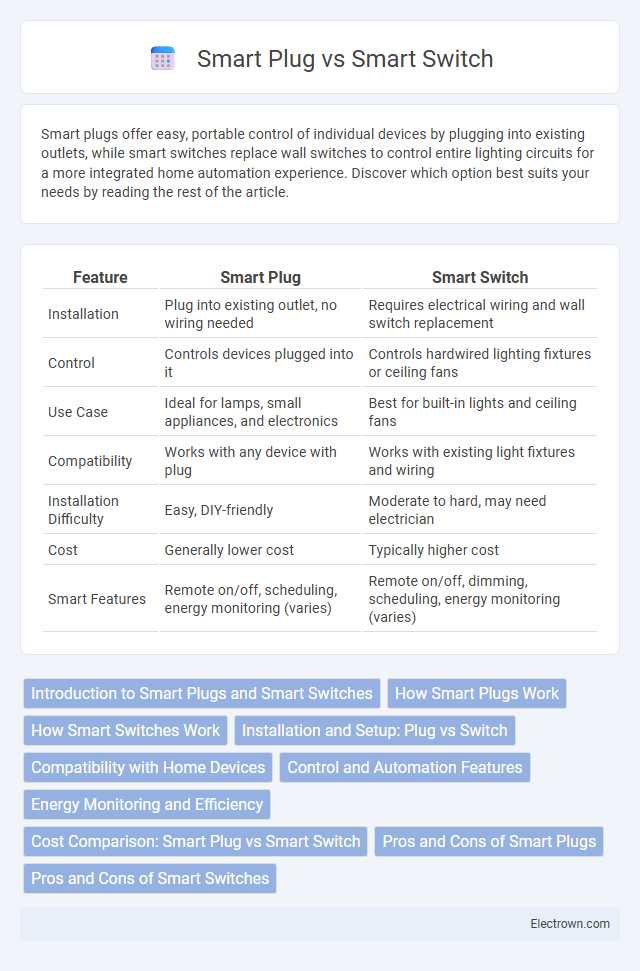Smart plugs offer easy, portable control of individual devices by plugging into existing outlets, while smart switches replace wall switches to control entire lighting circuits for a more integrated home automation experience. Discover which option best suits your needs by reading the rest of the article.
Table of Comparison
| Feature | Smart Plug | Smart Switch |
|---|---|---|
| Installation | Plug into existing outlet, no wiring needed | Requires electrical wiring and wall switch replacement |
| Control | Controls devices plugged into it | Controls hardwired lighting fixtures or ceiling fans |
| Use Case | Ideal for lamps, small appliances, and electronics | Best for built-in lights and ceiling fans |
| Compatibility | Works with any device with plug | Works with existing light fixtures and wiring |
| Installation Difficulty | Easy, DIY-friendly | Moderate to hard, may need electrician |
| Cost | Generally lower cost | Typically higher cost |
| Smart Features | Remote on/off, scheduling, energy monitoring (varies) | Remote on/off, dimming, scheduling, energy monitoring (varies) |
Introduction to Smart Plugs and Smart Switches
Smart plugs and smart switches both enhance home automation by enabling remote control of electrical devices via smartphone apps or voice assistants. Smart plugs connect directly to existing outlets, allowing you to automate and monitor appliances without rewiring, while smart switches replace traditional wall switches for integrated control of hardwired fixtures. Understanding their distinct installation methods and control capabilities helps you choose the best solution for your smart home setup.
How Smart Plugs Work
Smart plugs work by connecting to a home's Wi-Fi network, allowing users to control electrical devices remotely via smartphone apps or voice assistants. They act as intermediaries between the power outlet and the device, enabling features like scheduling, energy monitoring, and automation without requiring any wiring changes. Unlike smart switches, smart plugs are typically plug-and-play and can be easily moved between different outlets for versatile use.
How Smart Switches Work
Smart switches connect directly to your home's electrical wiring, enabling seamless control of built-in lighting fixtures through your smartphone or voice assistant. Unlike smart plugs, which control power outlets, smart switches replace traditional wall switches, allowing for integration with existing lighting circuits and schedules. Your ability to automate and customize lighting settings enhances convenience and energy efficiency throughout your living space.
Installation and Setup: Plug vs Switch
Smart plugs offer a simple installation process by plugging directly into an existing outlet, requiring no wiring expertise or tools, making setup quick and user-friendly. Smart switches demand replacing your current wall switch, involving electrical wiring and potentially turning off your home's power to ensure safety, which may require professional installation. Your choice depends on whether you prefer an easy plug-and-play option or a more integrated, hardwired solution for controlling your lighting.
Compatibility with Home Devices
Smart plugs offer broad compatibility with various home devices by simply plugging into existing outlets, making them ideal for controlling lamps, appliances, and electronics without rewiring. Smart switches integrate directly into home wiring, providing seamless control over built-in lighting fixtures and ceiling fans while requiring compatibility with the home's wiring system and load type. Both devices support major smart home platforms like Amazon Alexa, Google Assistant, and Apple HomeKit, but smart switches often require neutral wires for installation and are better suited for permanent setups.
Control and Automation Features
Smart plugs offer plug-and-play control for individual devices, enabling you to schedule, monitor energy usage, and remotely operate appliances through smartphone apps or voice assistants. Smart switches replace existing wall switches, providing seamless integration with home lighting systems and allowing control over multiple fixtures or entire circuits. Both devices support automation features like timers, scenes, and voice commands, but smart switches deliver more robust control for built-in lighting infrastructure, enhancing your home's connected ecosystem.
Energy Monitoring and Efficiency
Smart plugs provide detailed energy monitoring by measuring real-time power consumption of individual devices, allowing users to track and reduce energy usage effectively. Smart switches control fixed lighting or appliances with integrated energy-saving features but generally lack granular consumption data. For precise energy efficiency management, smart plugs offer superior monitoring capabilities compared to smart switches.
Cost Comparison: Smart Plug vs Smart Switch
Smart plugs generally cost less upfront, making them an affordable option for automating individual appliances without complex installation. Smart switches tend to have a higher initial price due to integrated wiring and compatibility with existing electrical systems, but they control entire circuits, offering more comprehensive home automation. Your choice depends on whether you prioritize budget-friendly convenience or long-term control efficiency.
Pros and Cons of Smart Plugs
Smart plugs offer easy installation and portability, allowing users to control devices remotely without rewiring, making them ideal for renters or temporary setups. They consume minimal power and provide smart home integration with popular assistants like Alexa and Google Home. However, smart plugs can be bulky, potentially blocking adjacent outlets, and may not handle high-power appliances safely, limiting their use for certain devices.
Pros and Cons of Smart Switches
Smart switches offer the advantage of controlling built-in wiring for multiple devices and provide seamless integration with existing light fixtures, enhancing home automation efficiency. They may require professional installation due to complex wiring and can be less flexible than smart plugs when relocating devices. The durability and compatibility with voice assistants make smart switches a reliable choice for long-term smart home setups.
Smart Plug vs Smart Switch Infographic

 electrown.com
electrown.com